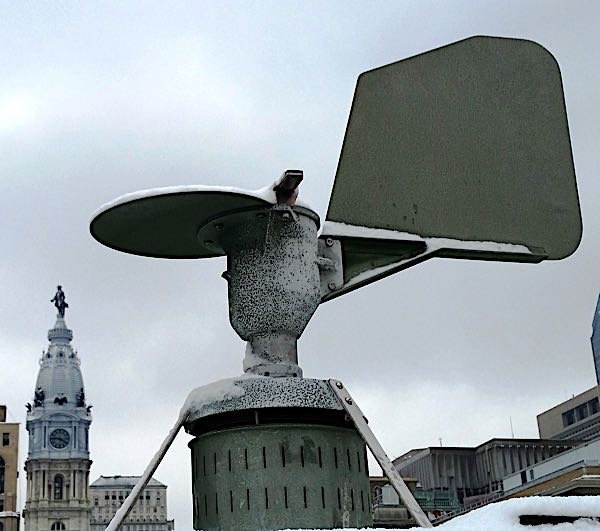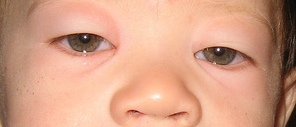Uncategorized
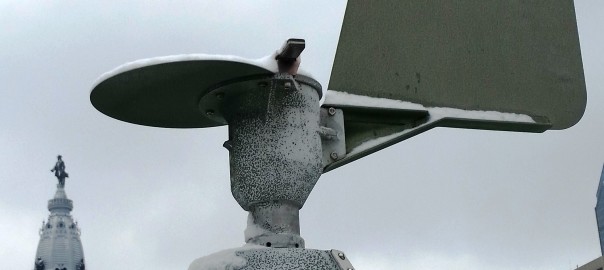
April 28, 2016. Thursday Tree Pollen Tale: Very High,Down Not Out
“When I saw the air samples, I knew tree pollen would be down. It was that obvious.” Dr. Dvorin reports as he finished counting today’s air sample. Unfortunately, even with a drop in volume, Tree Pollen remains in the very high range.
“Volume is never the whole story with pollen—we know the process of pollen production is disturbed by weather changes like rain and or falling temperatures, “ explained Dr. Dvorin. “Take today’s count for example: the kinds of pollen matter. In other words, what is actually in the air plays a role during the height of the season, and why local air samples provide crucial information. ”
Tree pollen today is very high. In the Delaware Valley, tree pollen counts of 60-999 pollen grains per cubic meter of air in a 24 hours period are very high and may cause moderate to severe symptoms. Compared to yesterday tree pollen count, overall volume fell between 50-55%.
Oak Tree Pollen continues to dominate the count; however, variation was noted today between The Asthma Center’s suburban (Mount Laurel, NJ) air sample versus the urban air sample (Philadelphia, PA-Collection Station Pictured Above). In the suburban air sample, Oak Tree pollen accounted for approximately 84% of all tree pollen and continues the trend seen in the air samples from both collection stations over the last several days. Of note, in today’s Philadelphia air sample Oak tree pollen comprised only a little more than 50% of the overall tree pollen count.
In The Asthma Center’s Philadelphia, PA pollen count, Mulberry tree pollen increased in both volume and as percentage, comprising nearly 35% of the overall tree pollen in the urban air sample today. (Don’t miss Dr. Dvorin’s commentary on “Street Tree Mulberry” in the Delaware Valley.) Birch Tree pollen was a distant third in the Philadelphia pollen count. Mulberry and Birch tree pollen tie for second place in the Mount Laurel, NJ pollen count, together account for close to 10% of the air sample. Today’s grass pollen counts are low, and outdoor mold spores remain high.
What’s Ahead?
It’s raining in the Delaware Valley, and more rain is in the forecast from now through Monday.
For allergy and asthma sufferers, it’s the not the forecasts that matter, but “what’s in the air.”
When asked about “pollen forecasts” which are popular in the news and online today, Dr. Dvorin warns with a smile “Take them with a grain, a grain of salt that is, not a pollen grain.”
“That’s because there is no published, scientifically validated model for pollen forecasting,” Dr. Dvorin explains. The accuracy and statistical correlation of pollen counts with pollen forecasts has never been proven. “That’s why I collect and count the local pollen and mold spores for New Jersey and Pennsylvania—so that we can all know “what’s in the air!”
Be sure to check back in for The Asthma Center’s daily Pollen and Mold Spore Count, the Delaware Valley’s only Official count station which is certified by the National Allergy Bureau. Subscribe to receive our daily counts by email or check out some of our other blog posts to learn more about what is in the air, how it can affect you, and what you can do about it.
What Can You Do?
1. Be proactive—know what triggers your symptoms (allergy skin testing) and limit or avoid exposure. This is the strategy The Asthma Center’s board certified Allergists employ to help patients get relief.
2. If you’re on medications to manage your allergies, don’t stop taking them because it rains or temperatures are cooler. With allergies, if you stop taking your medications and then suddenly have more exposure to a trigger (like Tree Pollen levels re-surging when things dry out), your allergy symptoms may even be worse.
Get Relief-Saturday appointments are available!
The best way to manage your allergies is to find out exactly what’s causing your symptoms. The Asthma Center has 9 locations in PA & NJ with the following Saturday hours in addition to our normal Monday – Friday business hours.
• May 7 and May 14: the Mount Laurel, NJ location will be seeing patients.
• May 14 and June 4: the Langhorne, PA office will be seeing patients.
More Info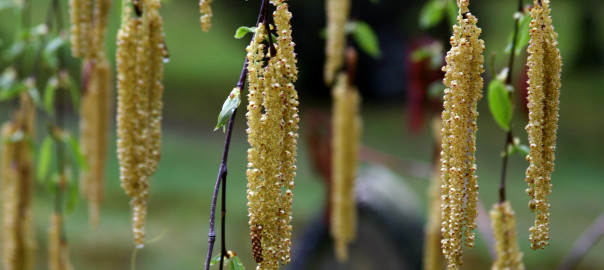
April 27, 2016. Weathering Wednesday: Tree Pollen Won’t Wash Away
Quick heavy rains with wind deposited between 0.25 – 0.5 of an inch of rain throughout our area last evening. If you were caught out in it, the clouds moved in fast and the downpour felt more like an inch. In downtown Philadelphia, umbrellas blew inside out, and in the suburbs lawn furniture tipped over. Sunshine returned, but behind the storm, temperatures fell (closer to historical averages). Allergy sufferers hoping for a break from symptoms were likely disappointed.
“The numbers went down, but not that much” says Dr. Dvorin as he finished counting today’s air sample. “And expect a resurgence as soon as the ground dries out, 24-48 hours after the storm,” he warns.
Today’s tree pollen count for the Delaware Valley is approximately 935 grains per cubic meter of air. For our local area, tree pollen counts 60-999 are very high and may cause moderate to severe symptoms. The composition of today’s tree pollen count was similar to what has been in evidence over the last several days with Oak tree pollen accounting for more than 80% of all tree pollen. Pine and Mulberry again hold second place and together account for close to 10% of the air sample (Don’t miss Dr. Dvorin’s Manic Monday commentary which includes an explanation of the impact of Pine and Mulberry trees in the Delaware Valley) Today’s grass pollen counts are low, and outdoor mold spores remain high.
How much difference did the rain make for Tree Pollen Counts?
For the big three, Oak, Pine and Mulberry, the following decreases were noted:
The amount of rain our area received varied, but analysis of The Asthma Center’s air sample counts for the “big 3” (Oak, Pine & Mulberry) shows that overnight Oak tree pollen decreased 14 – 28%, Pine Tree pollen decreased 43-55%, and Mulberry Tree pollen decreased 43-63%.
What’s Ahead?
Clouds, more rain and cooler temperatures are in the forecast for our area with predictions for precipitation from now through Monday, but allergy and asthma sufferers shouldn’t count on a break from symptoms.
“As things dry out, expect pollen levels to bounce. If it’s humid, outdoor mold spore levels may climb.” says Dr. Dvorin “but we’ll know for sure when I do the counts.”
Be sure to check back in for The Asthma Center’s daily Pollen and Mold Spore Count, the Delaware Valley’s only Official count station which is certified by the National Allergy Bureau. Subscribe to receive our daily counts by email or check out some of our other blog posts to learn more about what is in the air, how it can affect you, and what you can do about it.
What’s Can You Do?
- Be proactive—know what triggers your symptoms (allergy skin testing) and limit or avoid exposure. This is the strategy The Asthma Center’s board certified Allergists employ to help patients get relief.
- If you’re on medications to manage your allergies, don’t stop taking them because it rains or temperatures are cooler. With allergies, if you stop taking your medications and then suddenly have more exposure to a trigger (like Tree Pollen levels resurging when things dry out), your allergy symptoms may even be worse.
Get Relief-Saturday appointments are available!
The best way to manage your allergies is to find out exactly what’s causing your symptoms. The Asthma Center has 9 locations in PA & NJ with the following Saturday hours in addition to our normal Monday – Friday business hours.
- May 7 and May 14: the Mount Laurel, NJ location will be seeing patients.
- May 14 and June 4: the Langhorne, PA office will be seeing patients.
More Info
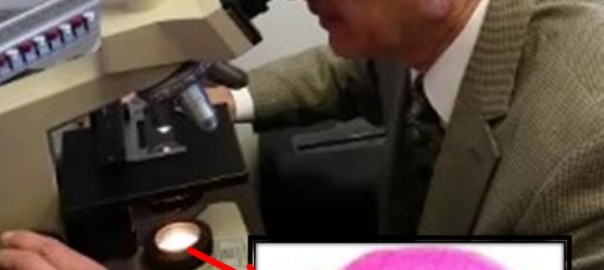
April 26, 2016. Extreme Tree+Grass Misery = Terrible Pollen 2sday
“It’s been dry and breezy with no rain yet, so tree pollen levels are extreme again today,” reports Dr. Dvorin. “There has been a slight decrease in the last 24 hours, but the volume of Oak tree pollen and all tree pollen remains heavy.”
Today’s tree pollen count is well above 1000 (see How We Count Pollen) which is in the extreme range with the potential to trigger severe allergy symptoms.
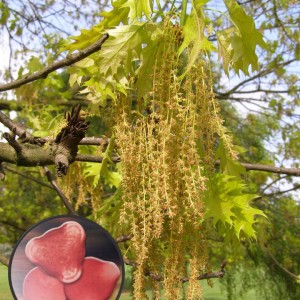
Oak tree pollen (pictured above) accounts for more than 80% of all tree pollen in our air in the Delaware Valley. In fact, Oak tree pollen counts alone fall into the extreme range. Pine & Mulberry pollen are in second place today and account for another approximate 10% of the tree pollen in our local air sample. The remaining 2% or so is comprised of Juniper/Cedar, Birch, Walnut, Willow, Sweet Gum, Sycamore, and Hemlock tree pollen.
Grass pollen decreased slightly today and falls just short of moderate into the low range. Outdoor mold spores, on the other hand, are slightly increased but remain in the high range.
What You Need to Know About Grass Pollen
Grass pollen allergy is an example of why it is so important to know exactly what is causing your allergy symptoms, how sensitive you are to this trigger, and how to limit or avoid your exposure because even the smallest amounts of grass pollen can cause symptoms in those who are extremely sensitive.
Grass pollen is in the Delaware Valley today, and there is no doubt these numbers are on the rise. Based on Dr. Dvorin’s historical data, grass pollen in our area typically appears in early April, peaks during the month of May, and then gradually declines in June. A second, less intense burst of grass pollen is usually seen in the Delaware Valley from late August through early October.
For those with grass pollen allergy, it’s crucial to recognize your symptoms when they first appear and to be knowledgeable about your management and treatment options.
Grass Pollen Allergy Symptoms
Many individuals recognize the “typical” spring allergy symptoms triggered by grass and tree pollen such as sneezing, itchy and watery eyes, and congestion. Less commonly recognized is the fact that grass pollen may be the source behind puffy eyes (eye allergy) and contact skin or rashes (skin allergy.) Many individuals are allergic to both trees and grass, making this time of year particularly miserable (don’t miss our recent blog: Blue Skies, Red Eyes)
It is particularly important to keep grass pollen allergy in mind as young children spend more time outside playing on sports fields (such as soccer, lacrosse or baseball) with grass. Also, just as adults may experience fatigue or difficulty concentrating when allergy symptoms are at their worst, allergies can affect children in the same manner. Fatigue and concentration issues (other allergy symptoms) sometimes first show up in problems at school.
Grass Pollen Sensitivity
At The Asthma Center, we know that no two people are exactly alike – which is why our evaluations and treatment programs are customized and tailored to fit each patient’s allergies, asthma, and sinus needs and concerns. Grass pollen sensitivity is just one part of our Allergy Skin Test. Based on our board certified Allergists clinical experience and Dr. Dvorin’s historical aeroallergen data, our team of specialists can help determine your level of sensitivity to the most common grasses in the Delaware Valley including June, Kentucky Blue, Meadow Fescue, Orchard, Perennial Rye, Redtop, Sweet Vernal, and Timothy.
How to Avoid or Limit Grass Pollen Exposure
 The first step in avoiding or limiting grass pollen exposure is to know when grass pollen is present in the air. Dr. Dvorin collects, counts, and reports local air samples for the Delaware Valley every day Monday through Friday. Pictured here is a grass pollen grain right from his microscope today.
The first step in avoiding or limiting grass pollen exposure is to know when grass pollen is present in the air. Dr. Dvorin collects, counts, and reports local air samples for the Delaware Valley every day Monday through Friday. Pictured here is a grass pollen grain right from his microscope today.
If you have grass pollen allergy and know your sensitivity, and know when grass pollen is present in your local air, you can avoid or limit your exposure by:
- Limit time outdoors during the early morning hours when the most pollen is released into the air
- Sleep with windows closed and drive with windows up (Don’t miss our recent blog Shut the Door, Seal the Windows )
- Wear long sleeves and long pants when mowing the grass
- Beware of tracking grass pollen into your home (kids and pets especially)
- Shower and wash your hair after being outdoors
Grass Pollen Allergy Treatment
Grass pollen allergy treatment options are similar to other pollen treatments, and many factors will play a role on what is the best treatment plan for you. If your allergies are making you miserable, it is best to see a qualified (board certified) allergist who can evaluate and help you manage your specific issues. Allergies are often mis-diagnosed with other non-allergic conditions but with the proper diagnosis and customized treatment, it is possible to get relief!
Allergy shots have been shown to be of help to some individuals with grass pollen allergy. Another form of immunotherapy, sub-lingual (where a tablet is dissolved under the tongue) has recently become available for the treatment of grass pollen allergy. Unfortunately, studies have shown that this treatment works best when an individual has a single allergy but it is rare for an individual to only be allergic to grass pollen. In The Asthma Center’s experience, it is much more common for individuals to have multiple triggers with unique levels of allergic sensitivity and therefore a personalized approach is required in order to achieve the best outcomes and help our patients get relief.
To benefit from allergy shots or sub-lingual immunotherapy, these treatments should be started approximately three months before the season. While it may be too late to start allergy shots for the 2016 Spring season, it’s not too late to Get Relief, starting with allergy skin testing to determine your specific triggers and levels of allergic sensitivity!
Did you know?
Research has established that allergies are “passed down, ” and there is a clear hereditary risk. When there is one parent with allergies, a child has approximately a 33% risk of developing allergies. When both parents have allergies, the risk jumps to approximately 70%.
Want to Know More About What’s in the Air?
The Asthma Center is the Delaware Valley’s only Official Pollen and Mold Spore count station which is certified by the National Allergy Bureau. Subscribe to receive our daily counts by email or check out some of our other blog posts to learn more about what is in the air, how it can affect you, and what you can do about it.
Get Relief-Saturday appointments are available!
The best way to manage your allergies is to find out exactly what’s causing your symptoms.The Asthma Center has 9 locations in PA & NJ with the following Saturday hours in addition to our normal Monday – Friday business hours.
- May 7 and May 14: the Mount Laurel, NJlocation will be seeing patients.
- May 14 and June 4: the Langhorne, PAoffice will be seeing patients.
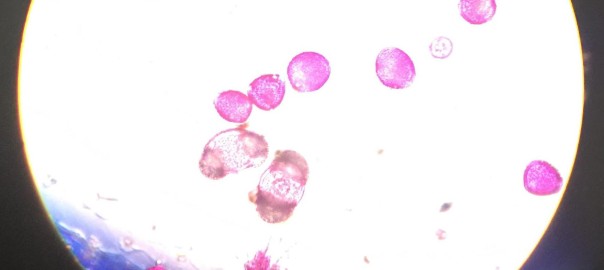
April 25, 2016. Manic Monday: Tree Pollen levels Extreme today in the Delaware Valley
“Looks like a bad week for allergies. Today tree pollen is extreme, and I expect to see peak tree pollen in the next five days,” says Dr. Dvorin as he finished today’s count. The picture above was taken right from his microscope and features, Oak, Pine and Walnut tree pollen.
The Asthma Center’s phones are busy with reports of misery: nasal congestion and blockage, sneezing, itchy eyes, and coughing!
“Even though we have rain in the forecast for tonight,” Dr. Dvorin goes on, ”that’s only temporary and within 24-48 hours things are dried out and tree and grass pollen will be present in the air again. Rain and thunderstorms will lead to more outdoor mold spores as well.”
More than three quarters of today’s air sample is comprised of Oak tree pollen. Oak is the predominant hardwood tree species in the Delaware Valley, and a single medium to large Oak tree can produce several million pollen grains. When you consider how tiny each pollen grain is (24-38 micrometers), that’s a lot of tree pollen.
Keeping that in mind, it is no surprise in our area that Oak tree pollen often dominates the tree counts for stretches of time.
Birch Tree pollen grains are actually increased in today’s air sample for our area and comprise approximately 10% of tree pollen grains in the air. Next largest in volume is Walnut tree pollen which amounts to between 6-9% of the tree pollen grains in the air.
Two Stations are Better than One
At this point, our air samples take a turn which provides crucial information for allergy sufferers who know exactly which species trigger their symptoms (Allergy Skin Testing). In Philadelphia, where there are more Mulberry trees (See Street Tree Mulberry Struts its Stuff), Mulberry is the fourth largest contributor of pollen grains to the air. Across the Delaware in New Jersey, home of our national treasure the Pinelands, Pine trees are still pollinating and are the fourth largest contributor of pollen grains for this area. Generally speaking, there is minimal variation between The Asthma Center’s urban (Philadelphia) and suburban (Cherry Hill, NJ) air sampling stations. However, on days like today’s “Manic Monday” with extreme levels of tree pollen, it is critical for allergy sufferers to know what’s in the air in their local area. It is also important to remember that weather and wind currents play a role in distributing pollen. Tree pollen is light and can travel for miles, meaning Philadelphia air may contain pollen from the Jersey Pinelands and vice versa. That is why The Asthma Center uses two stations to get a better understanding of this expansive area.
Six other kinds of trees make up the remainder of tree pollen. They are in varying stages of their cycles – some at the end of their pollinating seasons while others are just getting started. Outdoor Mold spores were increased (likely due to the rain in our area this past weekend) and remain in the high range. Grass pollen is slightly increased today, and continues to be present at moderate levels. If you are extremely sensitive to this allergen, you may already be feeling symptoms of grass pollen allergy.
Did You Know?
Manic Monday was released by The Bangles in 1986 on their album Different Light and peaked at No.2 on Billboard’s Hot 100. But did you know that the song was written by the recently deceased pop mega-star Prince? Under the pseudonym “Christopher”, Prince penned the song originally for the group Apollonia 6. Two years later, he offered it to The Bangles and the rest, as they say, is history.
Want to Know More About What’s in the Air?
The Asthma Center is the Delaware Valley’s only Official Pollen and Mold Spore count station which is certified by the National Allergy Bureau. Subscribe to receive our daily counts by email or check out some of our other blog posts to learn more about what is in the air, how it can affect you, and what you can do about it.
Get Relief-Saturday appointments are available!
The best way to manage your allergies is to find out exactly what’s causing your symptoms.The Asthma Center has 9 locations in PA & NJ with the following Saturday hours in addition to our normal Monday – Friday business hours.
- May 7 and May 14: the Mount Laurel, NJlocation will be seeing patients.
- May 14 and June 4: the Langhorne, PAoffice will be seeing patients.
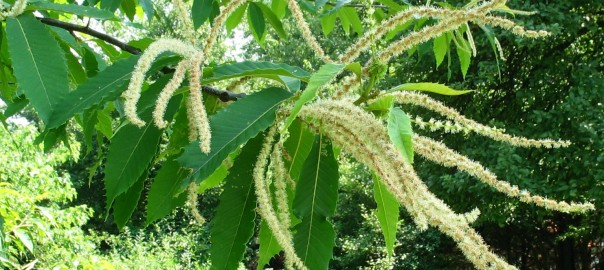
April 21, 2016. Shut the Door, Seal the Windows: Catkins Are Here
“We had colder temperatures overnight, but Tree pollen remains present at very high levels. Again today, Oak tree pollen accounts more than 50% of the pollen in the air, here in the Delaware Valley, right now,” said Dr. Donald Dvorin. Before Oak tree pollen is released into the air, it is stored in nature’s warehouse which is the male Catkin (see picture above.)
While more than half of today’s air sample is comprised of Oak tree pollen, Juniper/Cedar and Walnut tree are tied for second place. Combined, these two kinds of tree pollen account for almost another 15% of all pollen grains in the air. Less than 5% of the pollen in our local air today is Birch tree pollen, which puts Birch at a distant third place. The remaining 30% is made up of 6 other kinds of trees (some at the end of their pollinating seasons while others are just getting started.) And let’s not forget Grass pollen rising, and Mold spores holding steady at high levels. Regarding grass pollen, if you are extremely sensitive to this allergen, even though Grass pollen levels are moderate, you may already be feeling symptoms of grass pollen allergy.
Sneezing, wheezing, itchy eyes, congestion, and many more symptoms of allergy alert us that pollen levels may be high. Another warning sign is the yellow coating found each morning on car windshields, outdoor furniture, and even on pets who are outside in the morning when pollen counts are highest.
Another source of pollen exposure which often goes unrecognized: For those who still receive newspapers delivered to their homes, these newspapers usually lay in your driveway or on your doorstep during the morning hours when most pollen is released into the air. The result is that a layer of pollen collects on the plastic sleeve and then, unknowingly, a significant amount of pollen is brought into the home.
With tree pollens prevalent, and Oak tree pollen predominant, it helps to know how pollen travels. For Oak (and many other trees), catkins are the pollen bearers.
What is a Catkin? (See Picture Above)
A catkin is a slim, cylindrical cluster of flowers without petals that you have undoubtedly seen covering your cars in the late spring. Catkins have a different look, texture, and color than foliage leaves and usually hang down from the tree’s branches. The term Catkin refers to an Old Dutch word katteken, meaning “kitten.” This is because of the resemblance catkins have to a kitten’s tail.
Male catkins are the warehouse where pollen is stored. To spread successfully, male catkins tend to dangle so that the slightest breeze might carry their pollens to their female counterparts. When the pollen reaches the female, acorn development begins.
As a direct result of this process, pollens find their way on our car windows and in our faces. Over time, these drooping reproductive agents will fall from where they have formed, but not before wreaking havoc on allergy sufferers.
Beware: Catkins Attack!
You may be used to seeing catkins littering your windshield, depending on where you live. What you may not know is that failing to remove them could be dangerous for your vehicle. There are several drains between the hood of your car and your windshield. Failing to routinely clear the catkins off of your windshield could lead to debris getting into your drains, resulting in water build up and eventual damage to the electrical components of your vehicle.
Double-Threat:
In addition, to posing a severe and costly threat to your automobile, catkins collecting on the hood of your car and your windshield pose a double-threat because pollen can enter your car through the vents. If you have spring allergies, particularly tree pollen allergy, you likely know to keep your car windows up to avoid pollen exposure. Unfortunately, you may have all your typical allergy symptoms of sneezing, itchy, watery eyes, congestion and more, if your car is not kept free of catkins–all because the tree pollen stored in catkins has made its way inside your vehicle!
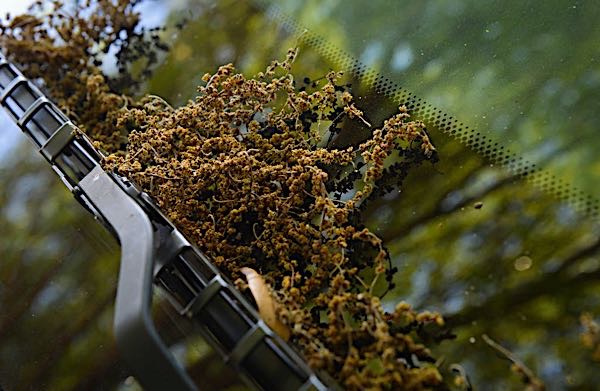
Want to Know More About What’s in the Air?
The Asthma Center is the Delaware Valley’s only Official Pollen and Mold Spore count station which is certified by the National Allergy Bureau. Subscribe to receive our daily counts by email or check out some of our other blog posts to learn more about what is in the air, how it can affect you, and what you can do about it.
Get Relief-Saturday appointments are available!
The best way to manage your allergies is to find out exactly what’s causing your symptoms.The Asthma Center has 9 locations in PA & NJ with the following Saturday hours in addition to our normal Monday – Friday business hours.
- April 30: the Woodbury, NJ location will be seeing patients
- May 7 and May 14: the Mount Laurel, NJ location will be seeing patients.
- May 14 and June 4: the Langhorne, PA office will be seeing patients.
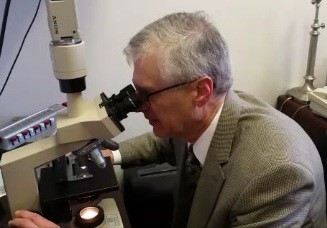
April 20, 2016. Blue Skies, Red Eyes: Oak Pollen on the Rise
Oak tree pollen is in the air here in the Delaware Valley. Today’s air sample slides were so coated in pollen that Dr. Donald Dvorin spent more than two hours at his microscope counting pollen grains and mold spores.
“Our patients are experiencing more eye symptoms this week,” he explained. “It’s why I set aside the time to count—to know exactly what’s in the local air today, our air right here, right now.”
The Asthma Center is the Delaware Valley’s only official pollen count station which is certified by the National Allergy Bureau (NAB.) Dr. Dvorin has more than 25 years of experience and training in the identification and counting of pollen grains and mold spores. All that experience comes in handy on a day like today when there were at least 12 identifiable kinds of tree pollen and nine kinds of mold spores.
“Without a doubt, Oak tree pollen is predominant right now and accounts for two thirds of all the pollen grains in today’s air sample,” says Dr. Dvorin. 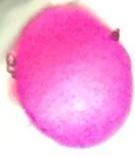
Pictured here is an oak tree pollen grain right from Dr. Dvorin’s microscopic view of today’s air sample slide. Oak trees are common in the Delaware Valley, and the sheer volume of pollen produced ranks it high on the list symptom-causing pollen for our area. (Read more from Dr. Dvorin, Oak’s No Joke: Packing an Early Punch this Spring.)
“Based on our historical pollen data and our clinical experience with patients, we know eye allergy symptoms increase around the same time Oak Tree Pollen peaks here locally,” explains Dr. Dvorin. “Given the eye allergy symptoms I’m seeing in patients right now, Oak tree pollen could peak in the Delaware Valley as early as one day this week, but that depends on a number of variables including the weather.”
If Oak tree pollen peaks this week, according to Dr. Dvorin’s historical data for our community, the 2016 peak would be a week to 10 days earlier than peaks of the last five spring pollen seasons. Be sure to check back daily for The Asthma Center pollen and mold spore counts or subscribe to receive The Asthma Center’s Daily Pollen and Mold Spore Count email.
“Spring pollen season is definitely the worst time of year for ocular allergies, and our patients are suffering with eye allergy symptoms,” confirms Dr. Marc Goldstein.
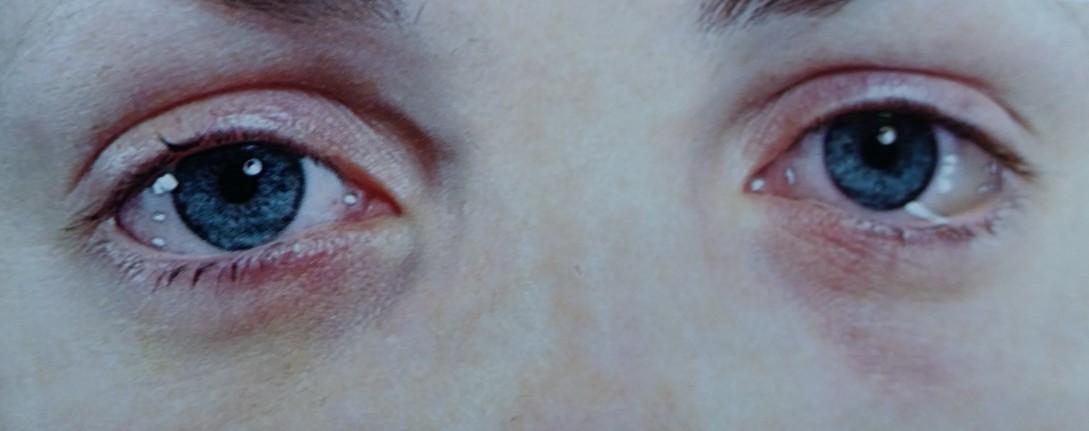
If you have itchy watery eyes, eyelid problems, dark circles around your eyes, dry eyes, or reactions to contacts, you may be experiencing eye allergy symptoms. Individuals with eye allergies may also experience crusting over the eyes in the morning. Unlike viral eye symptoms (such as “pink eye”), ocular allergies are not contagious. Eye allergy symptoms can vary in intensity from year to year, depending on exposure to triggering allergens like tree pollen. On days when the pollen counts are elevated, like today, symptoms can be severe.
How to Get Relief?
- Wear sunglasses or glasses outdoors to limit exposure of pollen to your eyes
- Avoid wearing contact lenses, or switch to daily disposable contacts to avoid allergens building up on the lenses
- Wash your hands and face frequently, including eyebrows
- Change your pillowcase often
- Visit an allergist to get prescription eye drops or to begin allergen immunotherapy (shots)
Did you know?
While dark circles under the eye are often associated with getting too little sleep, they are big indicators of allergic rhinitis. Especially present in children, these “allergic shiners” have been known to get darker as the severity of allergies increases. If your child has dark circles under their eyes or on their eyelids (a color similar to a bruise), it’s best to contact your physician/allergist to treat the underlying problem.
Get Relief-Saturday appointments are available!
The best way to manage your allergies is to find out exactly what’s causing your symptoms. The Asthma Center has 9 locations in PA & NJ with the following Saturday hours in addition to our normal Monday – Friday business hours.
- April 30: the Woodbury, NJ location will be seeing patients
- May 7 and May 14: the Mount Laurel, NJ location will be seeing patients.
- May 14 and June 4: the Langhorne, PA office will be seeing patients.

April 14, 2016. Sneak Peek: New Study Confirms Allergy Shot Safety
This morning, the American Academy of Allergy, Asthma, and Immunology (AAAAI) sent The Asthma Center an early preview of a manuscript which will be published later in the year. Researchers from Massachusetts General Hospital have confirmed the safety of allergy shots! No infectious related events occurred in more than 130,000 injections given to over 3,000 patients in a 10 year time frame (Balekian DS, Banerji A, Blumenthal K, Camargo Jr. CA, Long AA, Allergen Immunotherapy: No Evidence of Infectious Risk, Journal of Allergy and Clinical Immunotherapy 2016). In our experience at The Asthma Center over the past 25 years, we have administered more than an estimated million allergy shots with no infectious complications. Our extracts are prepared through compounding allergen extracts in our allergy laboratory and are customized and personalized for each individual patient’s allergic sensitivity. For many with allergies, allergy shots (allergen immunotherapy) are a crucial part of their medical management plan. Individuals with moderate to severe allergies often don’t find relief with medications or with attempts to avoid the environmental allergens which trigger their symptoms. The statistics can be staggering: Up to 30% of the U.S. population is suspected to have allergies, with the costs of treatments estimated to be in the billions and visits to doctors and lost days from school and work estimated to cost millions. Here at The Asthma Center, we focus on the toll on an individual’s health and quality of life. That is why our specialists are on the forefront on issues of safety and access to allergy shots. These efforts are beyond our day-to-day commitment to preparing and providing the highest quality allergen extract to our patients. We’ve also seen firsthand the difference allergy shots can make in controlling symptoms and improving daily life.
#SaveAllergyShots Update
In February 2016, The Asthma Center and NBC10 broke the story in the Delaware Valley that patient access to allergy shots was in danger of being dramatically limited. If you didn’t get a chance, be sure to watch Dr. Marc Goldstein’s interview http://bit.ly/1Sq8ttF. Access to allergy shots is threatened because an advisory board (United States Pharmacopeia-USP) has made recommendations to the FDA (Food and Drug Administration) about changing the regulations for compounding medications in general. The new regulations were in response to serious reports of infections that occurred with compounding, but not with compounding related to allergy shots. If the new regulations are approved, it will be unlikely that allergists will be able to continue preparing allergen extracts in the office. Nearly 16,000 supporters have signed the AAAAI petition for the FDA to keep regulations regarding allergy shots the way they are currently. Many of The Asthma Center patients have already signed and it’s not too late. The FDA has yet to rule on the recommendations. Please help us #SaveAllergyShots –Sign and share the AAAAI petition today https://www.change.org/p/united-states-pharmacopeia-save-patient-access-to-allergy-shots
More Info
April 6, 2016. Frosty Night for Locals: Understanding Spring Cold Snap
Jersey farmers aren’t the only ones thinking about this spring’s frost…
“It’s interesting how clear the air gets when there’s frost,” remarks Dr. Dvorin, Delaware Valley’s only official pollen and mold spore counter as he finished counting today’s air sample.
Our entire region was under a “frost warning” overnight. Within the City of Philadelphia, the mercury did drop below 32 degrees for a short while. Of more significance to plant life, our suburban communities saw much lower temperatures for a longer period of time.
“Weather plays such an important role in pollen and mold counts,” reminds Dr. Dvorin.
In order to understand “what’s (not) in the air today,” weather data is sometimes the most useful. To better understand how the cold snap affected today’s pollen count, Dr. Dvorin took a look at NOAA data this morning from all the suburban communities around our office locations.
In Pennsylvania from Bucks and Delaware Counties, and New Jersey from Camden, Mercer, and Ocean Counties, a pattern emerged: all areas reported temperatures below freezing for at least seven hours overnight, with most low temps settling in the mid-20s sometime between 5:30 a.m. and 7:00 a.m. Down the shore, near The Asthma Center’s Forked River, NJ office, temperatures dipped as low 16 degrees.
“Our patients who have been struggling with allergies and nasal congestion say there is some relief with this cold snap,” Dr. Dvorin reports. “With trees and freezing temperatures, the buds that had started to open will tighten up to protect the process,” he explains. “And if temperatures warm up – trees usually need about 48 hours or so—the buds will begin to reopen.”
Could 2016 bring early spring allergies and bad blueberries?
While frost can mean temporarily good news for allergy suffers, blueberry lovers and local farmers alike are holding their breath to see what the warm weather means for this year’s crop. Frost can be devastating to blueberries, and Hammonton (the “blueberry capital of the world”) now waits to see much harm the frost brought.
While we may have to wait for the news on Jersey blueberries, allergy sufferers don’t have to wait for Delaware Valley’s pollen and mold spore count. Check back daily for Dr. Dvorin’s updates and The Asthma Center pollen and mold spore counts or subscribe to receive The Asthma Center’s Daily Pollen and Mold Spore Count email.
Get Relief-Saturday appointments are available!
The best way to manage your allergies is to find out exactly what’s causing your symptoms. The Asthma Center has 9 locations in PA & NJ with the following Saturday hours in addition to our normal Monday – Friday business hours.
- April 16: our Bala Cynwyd, PA and Langhorne, PA offices will be seeing patients.
- April 23: the Northeast Philadelphia (Welsh Road) office will be seeing patients.
- April 30 and May 14: the Laurel, NJ location will be seeing patients.
- May 14 and June 4: the Langhorne, PA office will be seeing patients.
Watch Dr Dvorin’s explanation of the weather’s impact on our pollen season here.
More Info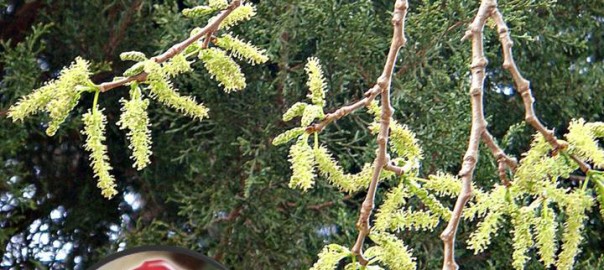
April 1, 2016. Street Tree Mulberry Struts its Stuff
“I saw the first mulberry tree pollen of 2016 today,” says Dr. Dvorin, Delaware Valley’s only official pollen and mold spore counter.
Dr. Dvorin went back to his records to see if mulberry also is running ahead of schedule. “It’s almost like clockwork for mulberry to show up today,” he adds. Just as Dr. Dvorin has observed and reported for other tree species (Oak’s no joke), mulberry tree pollen is 2 weeks early, and entering the scene at more robust levels than previous years. Dr. Dvorin’s local data for our region has, over the years, generally supported the assertion by The American College of Allergy, Asthma, and Immunology that mulberry tree pollination for our area is late April and May, sometimes extending into June. Weber, Richard W. On the Cover. Annals of Allergy, Asthma & Immunology. 2003 May;90(5):A6.
“We do skin test for mulberry allergy at The Asthma Center – paper mulberry and red mulberry – and have individuals who are positive, “says Dr. Dvorin. While little research is available on the prevalence of mulberry tree pollen allergy, Dr. Dvorin suspects that as many as 1 in 3 individuals who test positive for any tree pollen allergy may be allergic to mulberry tree pollen. Discovering the triggers for allergy symptoms and knowing “what’s in the air” can go a long way in helping allergy sufferers minimize exposures to triggers and reduce symptoms.
What’s in store for next week?
“That’s the big question,” says Dr. Dvorin. Colder temperatures are in most forecasts for our area for the next 7 – 10 days. “You know how forecasts can be,” he goes on to say. “It will be really interesting to see what happens if we have colder temperatures and what effect that will have on the pollination processes in the Delaware Valley.” Be sure to check back daily for The Asthma Center pollen and mold spore counts or subscribe to receive The Asthma Center’s Daily Pollen and Mold Spore Count email.
Did you know?
Mulberry trees are considered “street” trees because they have been popular with city planners. In fact, “Arch Street,” in Philadelphia was “Mulberry Street” until 1853. William Penn named many streets after trees as they were “things that grow spontaneously in the country. If you’re interested, you can visit a depiction of the Olde City Map in the plaza in front of the Ritz East Theater (125 South 2nd Street, Philadelphia).
Get Relief – Saturday appointments are available!
The best way to manage your allergies is to find out exactly what’s causing your symptoms. The Asthma Center has 9 locations in PA & NJ with the following Saturday hours in addition to our normal Monday – Friday business hours.
- April 16: our Bala Cynwyd, PA and Langhorne, PA offices will be seeing patients.
- April 23: the Northeast Philadelphia (Welsh Road) office will be seeing patients.
- April 30 and May 14: the Laurel, NJ location will be seeing patients.
- May 14 and June 4: the Langhorne, PA office will be seeing patients.
Watch Dr Dvorin’s explanation of the weather’s impact on our pollen season here.
More Info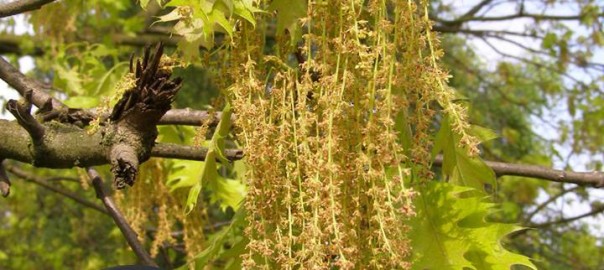
March 25, 2016. Oak’s No Joke: Packing an Early Punch this Spring
“I’m seeing unusual pollen distribution for Pine and Oak tree species,” says Dr. Dvorin, our expert pollen counter & board certified allergist. After counting today’s pollen and noting the oak and pine tree pollen levels, Dr. Dvorin took time to analyze his data from past spring seasons.
“Past peak levels for these trees support the common view that Oak and Pine trees are usually later-spring pollinators,” he continues. “This matters because Oak trees are one of the most common trees in the Delaware Valley.”
Dr. Dvorin goes on to explain that the sheer volume of pollen produced by Oak trees places it at the top of the list of “allergy-causing culprits” every spring in our area. “Unfortunately, just because the season arrived early and some trees are pollinating earlier doesn’t translate into a short season or an earlier end to allergy symptoms” says Dr. Dvorin. Once the allergies are triggered, even small amounts of a trigger (like pollen) or other irritants can cause misery.
The Asthma Center is the Delaware Valley’s only official pollen count station which is certified by the National Allergy Bureau (NAB). Dr. Dvorin has directly contributed not only to the field of pollen collection and counting for many years, but patients benefit directly from his work. Not only can allergy sufferers learn “what’s in the air,” the allergy specialists at The Asthma Center can test whether or not what’s in the air is triggering your specific symptoms. For example, The Asthma Center tests for types of oak tree pollen common to our area.
Did you know?
Spring sneezing and nasal congestion are just two of the many symptoms commonly associated with tree pollen allergy. Did you know that these symptoms lead to a telltale sign on the face? Not surprisingly, many allergy sufferers develop the habit of wiping or rubbing their nose in an upwards manner (known as the “allergic salute.”) Over time, this can lead to an observable crease across the nose. The habit develops, in part, because in addition to wiping mucus away, the act of pushing up the nose temporarily props open the air passages in the nostril to provide relief.
Get Relief – Saturday appointments are available!
The best way to manage your allergies is to find out exactly what’s causing your symptoms. The Asthma Center has 9 locations in PA & NJ with the following Saturday hours in addition to our normal Monday – Friday business hours.
- April 16: Bala Cynwyd, PA Langhorne, PA
- April 23: Northeast Philadelphia (Welsh Road)
- April 30: Mt. Laurel, NJ
- May 14: Mt. Laurel, NJ Langhorne, PA
- June 4: Langhorne, PA
To watch Dr Dvorin’s explanation of the El Nino effect on our pollen season, CLICK HERE.
More Info

